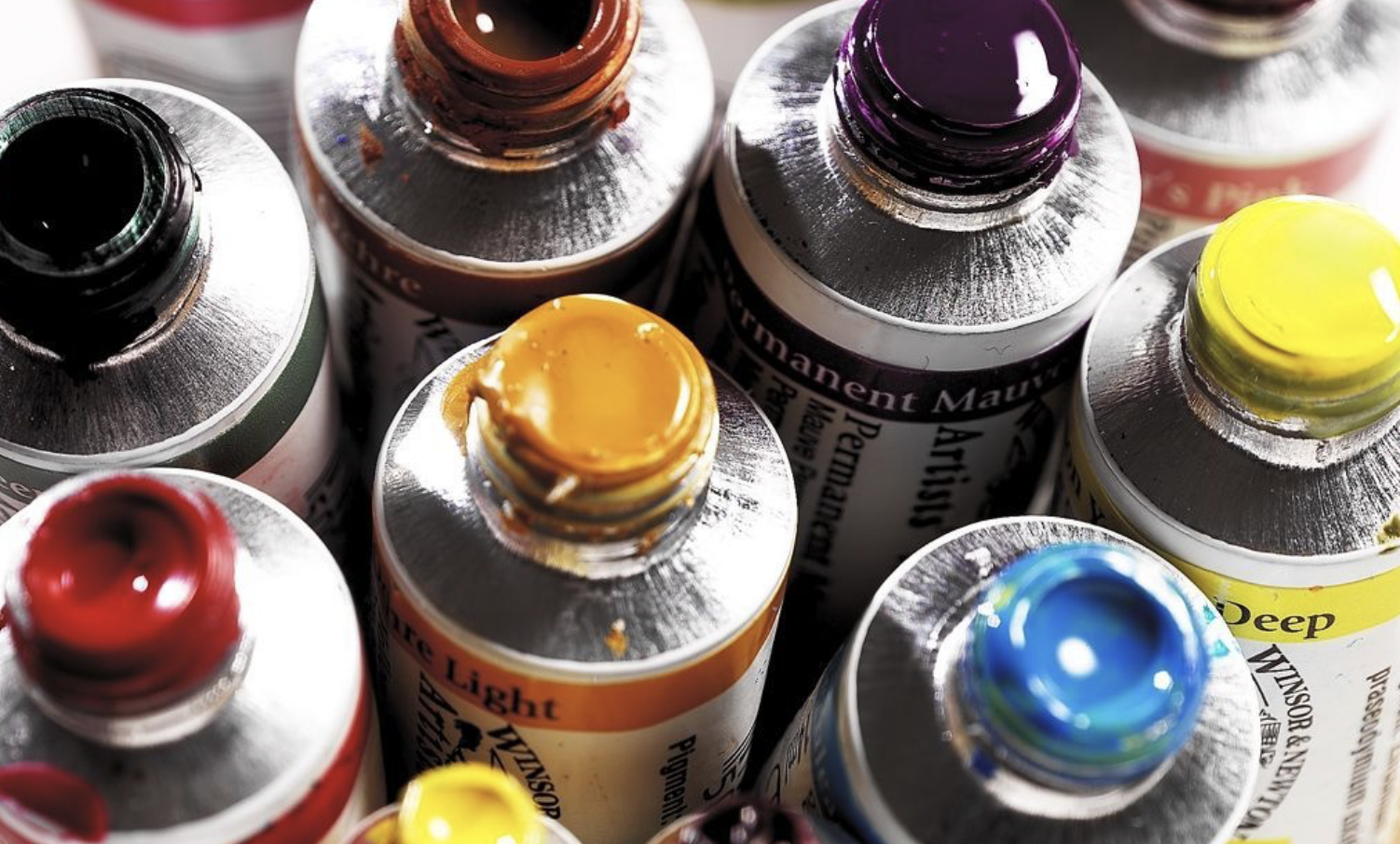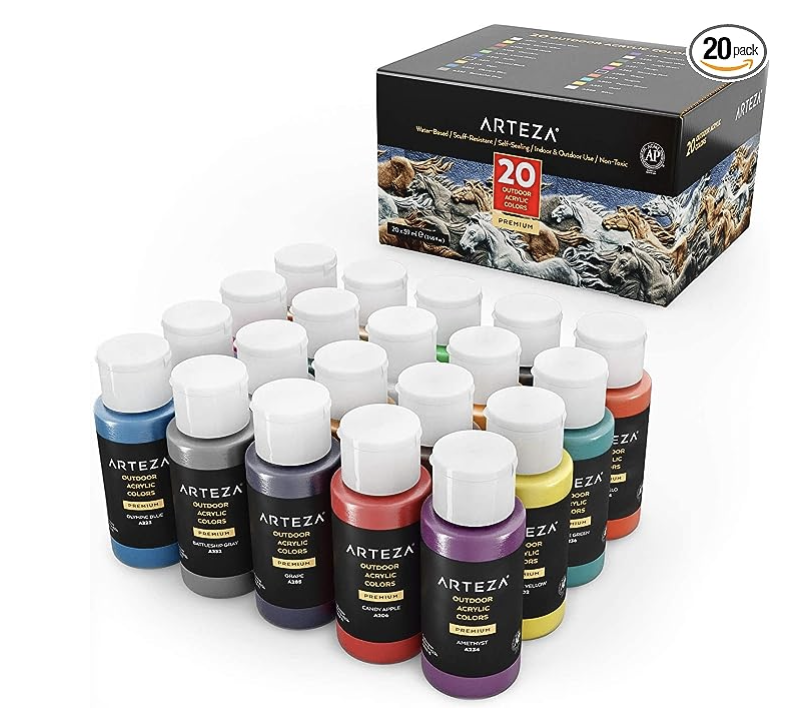{$te}
Explore our comprehensive guide to the finest acrylic paints, tailored to help you find the perfect match for your artistic endeavors
When deciding on the optimal acrylic paint, several factors warrant attention. These considerations may revolve around your requirements, budget, or a combination of both. For instance, do you require budget-friendly acrylic paint or are you inclined towards premium quality? Embarking on your acrylic paint exploration, foundational acrylic paints can aptly meet most requirements, offering user-friendliness and simple cleanup. The adaptability of acrylic paints extends to their compatibility with various surfaces. Irrespective of your expertise, we are here to assist you in discovering the finest acrylic paints for your needs.
What Makes Acrylic Paint Different?
Whether you're considering professional-grade acrylic paint or options suitable for beginners, the fundamental composition remains consistent. Foundational acrylic paints consist of pigments expertly suspended within an acrylic polymer solution. This suspension not only prevents pigments from merely floating or clumping in water, but also contributes to the uniform consistency of acrylic paint sets by dispersing the pigments evenly. Moreover, an array of additives further enhances the potential of creating products utilizing basic acrylic paints.
These additives may encompass:
- Preservatives that inhibit microbial growth, enhancing paint longevity.
- Thickeners to enhance paint consistency and flow.
- Surfactants that expedite the drying process.
- Defoamers to counteract surfactant effects.
- Buffers to regulate paint pH – consider exploring ammonia.
- Initiators to ensure efficient drying.
- Stabilizers to optimize paint flow.

Various Types of Acrylic Paint
Choosing the ideal acrylic paints involves more than just considering consistency – an aspect that might not directly correlate with paint quality. Professional acrylic paints are crafted using diverse formulations, each tailored to its intended purpose, the acrylic painting technique, and the specific medium in use.
Heavy body acrylic paints
To commence our exploration, one of the most widely favored options is heavy body acrylic paints, which bear a resemblance to oil-based paints in performance. These paints boast a luxurious, buttery consistency that facilitates the adept manipulation of paintbrush strokes, providing artists with a high level of control over their creative expressions. This texture lends itself well to a range of techniques, allowing for intricate detailing and bold applications alike.
Soft body paints
Moving forward, we turn our attention to the soft body paints, which present a notably smoother texture and possess the versatility to be seamlessly integrated with mediums. Their cream-like consistency lends itself exceptionally well to general painting applications, while also proving ideal for techniques such as pouring. On the other hand, acrylic paints featuring a more fluid, runny consistency are commonly known as fluid paints. This attribute makes them remarkably easy to spread, rendering them a prime choice for a multitude of painting methods, including the dynamic art of pouring.
Acrylic ink

An additional captivating choice in the realm of acrylic paints is acrylic ink. As the name suggests, this acrylic paint boasts a fluid-like consistency akin to ink. What truly sets it apart is the vividness of its color, surpassing that of its traditional acrylic counterparts. Upon drying, acrylic ink achieves a lustrous and impeccably smooth finish. Its adaptability is further highlighted by its compatibility with multiple tools – whether it be an airbrush, paintbrush, or pen. Should you opt to combine it with other acrylic paints in an airbrush application, the process can be facilitated by incorporating a thinning agent to achieve the desired consistency.
The duration it takes for acrylic paints to dry
It's essential to take into account the diverse drying times exhibited by acrylic paints. Although renowned for their rapid drying nature, there are specific formulations known as open paints that offer a slower drying process. This unique feature enables wet-on-wet painting techniques, a method typically associated with oil-based paints. Remarkably, these acrylic paints have been designed to emulate comparable characteristics, allowing artists to explore this technique within the acrylic medium.
Interactive Acrylics
Interactive acrylics introduce yet another imaginative choice to the array, following a standard acrylic drying process but with the added ability to be reactivated through an unlocking formula. This formulation can also be incorporated into foundational acrylic paints, effectively extending the drying timeline and affording you additional creative leeway. Upon achieving your desired color outcome, the final step involves sealing the paint using a Fast Medium Fixer to preserve the composition.
Acrylic Gouache

For those seeking a matte finish, exploring Acrylic Gouache proves to be a promising option. While traditional gouache is recognized as an opaque, watercolor-like paint, Acrylic Gouache diverges with its creamy consistency and unique characteristics. This professional-grade acrylic paint type incorporates an additive that yields the desired matte finish. Moreover, it exhibits a degree of water resistance, setting it apart from the attributes of traditional gouache.
Applying Acrylic Paints
As mentioned earlier, airbrushing stands out as one of the simpler and more efficient methods for applying acrylic paint. The airbrush tool effortlessly blankets your medium, accommodating various shapes and textures. When engaging with spray paints, it's imperative to work within a well-ventilated environment and prioritize your safety by donning protective gear like masks and goggles. The potential inhalation of paint fumes and particles underscores the importance of safeguarding your health against a range of potential issues.
While water-based spray paints can be employed indoors, it remains crucial to ensure proper ventilation and protective measures against paint splatter. Another advantage of utilizing acrylic paint through spraying is the degree of control it offers. The ability to manipulate the paint's direction and flow enhances precision when executing lines and intricate designs.
While water-based spray paints can be employed indoors, it remains crucial to ensure proper ventilation and protective measures against paint splatter. Another advantage of utilizing acrylic paint through spraying is the degree of control it offers. The ability to manipulate the paint's direction and flow enhances precision when executing lines and intricate designs.

Acrylic Paint Mediums
When working with fundamental acrylic paints, a multitude of mediums can be employed to alter the paint's inherent characteristics. These mediums facilitate adjustments ranging from modifying drying times to thickening or thinning the consistency, introducing texture, and bestowing a matte or glossy finish. Typically, these mediums are available in forms of gels, pastes, or liquids.
It's important to differentiate between mediums and additives – while additives necessitate precise measurements and adherence to provided instructions, mediums offer greater flexibility. You can incorporate mediums incrementally until the desired effect is attained. Let's delve into the array of available mediums.
Modeling Paste
This paste enables you to shape and texturize your artwork, lending it a three-dimensional appearance. By applying the dense paste to the desired area, you can gradually build upon it until it solidifies. This versatile paste can be sculpted or utilized to incorporate items within your artwork, offering a range of creative possibilities.
Texture Gels
Texture gels are precisely what the name suggests: they introduce texture. Comprising elements such as glass beads and natural sand, among others, these gels offer a diverse array of textural effects. While you can opt to blend sand directly into your acrylic paint mixture, the presence of impurities can potentially impact the stability of the paint. Embracing texture gels provides a chance to tap into your creativity, allowing you to experiment and fine-tune until you attain the desired artistic effect.

Gel Mediums
Contrary to its name, gel mediums are not in a gel-like state but rather exist in a paste form. This white substance serves multiple purposes, including the ability to augment the thickness of your paint. This attribute proves crucial if you aim to preserve visible brushstrokes within your artwork. Additionally, gel mediums excel as adhesives and find utility in assembling collages. Available in various variations, from matte to gloss, they extend the scope to incorporate textures into your creations.
Glazing Medium
Glazing mediums are an ideal choice when seeking to seamlessly blend edges with a transparent effect. It's crucial to exercise diligence when selecting a glazing medium, as oil-based variants may not interact harmoniously with acrylic paints. Instead, opt for gloss or satin sheen glazing mediums to achieve the desired results effectively.
Matte and Gloss Medium
Acrylic paints inherently possess a glossy finish; however, incorporating a matte medium can counteract this glossiness and yield a matte appearance. Conversely, the inclusion of a gloss medium can elevate the inherent vibrancy of the artwork. For a semi-gloss finish, consider experimenting with a combination of gloss and matte mediums, thereby striking a harmonious balance between the two.
If you find yourself needing more time to work with colors and textures, a retarding medium can slow down the drying process. On the other hand, if your paint appears too thick, thinning it out is a viable solution. Whatever addition you choose for your acrylic paint set, it's essential to read the instructions carefully. The assortment of mediums available provides a wide range of options for crafting your artistic masterpiece.
Top 10 Best Acrylic Paint Brands
As previously highlighted, ultimately, your choice of paint will be rooted in your personal preferences. Nonetheless, specific brands have earned recognition for producing high-quality products.
Popular high-quality acrylic paint brands include:
- Arteza Acrylic paints
- Utrecht Acrylics
- Sennelier
- Liquitex
- Chroma Atelier Interactive Artists’ Acrylics
- Golden Artist Colors
- Blickrylic Student Acrylic Paint
- Blick Studios Acrylics
- Winsor & Newton Professional Acrylics
- TriArt Liquid Acrylics
Our Team's Top Choice for Acrylic Paints
Embarking on a new hobby, or any new venture for that matter, can often feel quite overwhelming in the beginning. The realm of acrylic painting is no exception. The multitude of brands, paint options, color palettes, and mediums can initially leave you feeling taken aback. However, in the same vein, the possibilities that unfold through acrylic painting are boundless, promising substantial rewards once you find your footing.
Beginner acrylic paints, in particular, hold attributes that make them both user-friendly and advantageous. Being water-based and harmless, they provide a safe and comfortable avenue for exploration. Furthermore, their quick-drying and water-resistant properties make them especially suitable for artists on the go or those who prefer to create amidst the beauty of nature.
Beginner acrylic paints, in particular, hold attributes that make them both user-friendly and advantageous. Being water-based and harmless, they provide a safe and comfortable avenue for exploration. Furthermore, their quick-drying and water-resistant properties make them especially suitable for artists on the go or those who prefer to create amidst the beauty of nature.
In order to streamline this journey for you, we've curated a selection of top-tier acrylic paint sets, catering to both professional artists and beginners alike. These choices encompass a spectrum of quality levels and are readily accessible on Amazon, boasting a collection of highly positive reviews.
ARTEZA Acrylic Set

A widely favored option is the Arteza Acrylic Paint Set, which presents artists with a diverse array of colors enriched with vibrant pigments. Notably, it holds the distinction of being non-toxic, rendering it suitable for individuals of all ages, both children and adults.
Pros and cons
+ Extensive selection of vibrant and enduring colors
+ Exceptional quality
+ Non-toxic composition
+ High viscosity consistency
+ Impressive coverage capacity
-Individual paint colors are not available for separate purchase
Top All-Purpose Acrylic Paint Set: LIQUITEX BASICS

Yet another addition from Liquitex graces our list. This paint set offers premium-quality paints at an affordable price point. While the BASIC set features a slightly lower pigment concentration, it still manages to deliver vivid and vibrant colors. Comprising 12 paints with medium viscosity, this set proves user-friendly and easy to work with.
Buy acrylic LIQUITEX BASICS set here.
Buy acrylic LIQUITEX BASICS set here.
Pros and Cons
+ Exceptional pigment quality+ Versatility on various surfaces
+ Great value proposition
+ Suitable for both novices and experts
-Small tube sizes
Top Affordable Acrylic Paint Choice: CREATIVE JOY

If you're considering venturing into acrylic painting without a hefty investment, the Creative Joy Acrylic Paints emerge as a prime choice. Positioned as one of the finest economical acrylic paint options, they come at a price point under $10, offering a set of 12 paint tubes along with various brush sizes. This kit is exceptionally versatile, allowing you to paint on an array of surfaces, from paper to fabric and even wood.
Pros and Cons+ Budget-friendly
+ Diverse color selection
+ High-quality paints
-Not suitable for plastic materials
-Subpar packaging leads to paint drying out
-Limited coverage capacity
MyArtscape Acrylic Paint Set Professional

Elevate your artistic pursuits with the MyArtscape Acrylic Paint Set Professional. This meticulously crafted collection is tailored for the discerning artist seeking exceptional quality and versatility. With a rich array of pigments, this set encompasses a comprehensive spectrum of colors, enabling you to breathe life into your creative visions.
Each tube of acrylic paint within this set is formulated to deliver vibrant hues and impeccable coverage. The high pigment concentration ensures that your artworks radiate with striking intensity. Whether you're an established artist or a passionate beginner, the MyArtscape Acrylic Paint Set Professional accommodates all skill levels, facilitating seamless transitions from concept to canvas.
Each tube of acrylic paint within this set is formulated to deliver vibrant hues and impeccable coverage. The high pigment concentration ensures that your artworks radiate with striking intensity. Whether you're an established artist or a passionate beginner, the MyArtscape Acrylic Paint Set Professional accommodates all skill levels, facilitating seamless transitions from concept to canvas.
Pros and Cons
+ Multiple surface: for fabric, paper, canvas, ceramic, clay, wood, metal and nails & crafts.
+Superior lightfast
-High-priced
Castle Art Acrylic Set

Crafted for Simplicity: this set is designed to simplify your painting process. Whether you're aiming for bold strokes or intricate details, the paint can be easily squeezed directly onto your canvas or diluted with water. The robust tubes ensure longevity, free from drying or cracking, all elegantly encased in a sturdy presentation box.
Enduring Exploration: these generously-sized tubes, grouped in convenient color families, provide ample material for even the most prolific artists. Your creative journey will thrive with this comprehensive assortment at your fingertips.
Enduring Exploration: these generously-sized tubes, grouped in convenient color families, provide ample material for even the most prolific artists. Your creative journey will thrive with this comprehensive assortment at your fingertips.
Pros and Cons
+ Includes Unique fold-out tutorial
+Strong tubes – no drying or cracking
-The paints itself isn't too pigmented
Check out a video tutorial demonstrating how to paint an apple using acrylics
Frequently Asked Questions About Acrylic Paintings
What is acrylic paint, and how is it different from other types of paint?
Acrylic paint is a fast-drying paint made of pigment suspended in an acrylic polymer emulsion. Unlike oil paints that require a longer drying time, acrylics dry quickly and are water-resistant when dry.
Can acrylic paints be used on different surfaces?
Yes, acrylic paints are versatile and can be used on various surfaces such as canvas, paper, wood, fabric, glass, and even metal. They adhere well to most surfaces with proper preparation.
How can I thin acrylic paint if I need a transparent effect?
Acrylic paints can be thinned with water or acrylic mediums to achieve a transparent effect. Start with small amounts of water or medium and gradually add to the paint until you reach the desired transparency.
Can I mix different brands of acrylic paint together?
Mixing different brands of acrylic paint is generally fine, but keep in mind that the consistency and color might vary slightly. It's a good practice to perform some test mixing before applying to your artwork.
How do I clean my brushes after using acrylic paint?
Rinse your brushes immediately after use with water. For thorough cleaning, you can use a mild soap or acrylic brush cleaner. Avoid letting the paint dry on the brush bristles, as it can be challenging to remove later.
Are acrylic paintings permanent or prone to fading?
Acrylic paintings are relatively durable and resistant to fading, especially if they are properly protected from direct sunlight and extreme conditions. Using high-quality acrylic paints and archival materials can enhance the longevity of your artwork.
Can I paint over a dried acrylic painting?
Yes, you can paint over a dried acrylic painting. Acrylics create a stable surface that allows for layering. Make sure to clean the surface and apply a gesso layer before painting over it to ensure proper adhesion.
Can I varnish my acrylic painting?
Yes, varnishing your acrylic painting is recommended. Varnishes protect the painting from dust, UV rays, and environmental pollutants. There are matte, satin, and glossy varnishes available, each offering a different finish.
How do I create texture in my acrylic paintings?
You can create texture in acrylic paintings by using various techniques, such as layering thick paint, applying impasto gels, using palette knives, and incorporating additives like sand or modeling paste.
Can I mix acrylic paint with other types of paint?
While it's possible to mix acrylic paint with other water-based paints like watercolors or gouache, mixing with oil-based paints is not recommended due to their different chemical properties and drying times.











